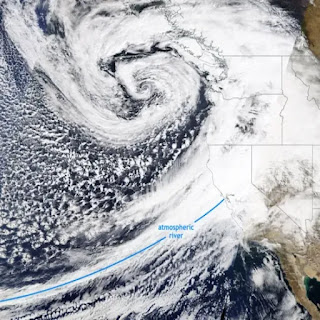ARTICLE AD BOX
Atmospheric rivers are long, narrow parts of the Earth's atmosphere that carry high amounts of moisture. They extend over tens to hundreds of kilometers in which moisture is transported from the Earth's tropical regions near the equator towards the poles. Therefore, they appear as rivers flowing in the sky.
On average, the Earth has 4 to 5 active rivers in the atmosphere at all times, and their moisture content is released in the form of rain or snow when the atmospheric rivers reach land.
Atmospheric rivers can vary greatly in size and strength. While a temperate atmospheric river carries an amount of water vapor roughly equivalent to the average water flow at the mouth of the Mississippi River , exceptionally strong atmospheric rivers can transport up to 15 times that amount.
How are sky rivers formed?
For any river to form in the atmosphere, three factors must be present together:
The first is the presence of strong, low-level winds that act as a rapid way to transport water vapor through it. The jet streams in the northern and southern hemispheres fulfill this condition, as their wind speeds reach 442 km/h (275 mph).
Next comes the necessity of high humidity levels.
Finally, the presence of rising terrain, such as mountain ranges, which in turn helps to transfer the air mass from a lower altitude to a higher altitude, as this contributes to the cooling of the air mass very quickly with increasing altitude, which raises the humidity in the air and ultimately leads to the formation of clouds, which release their contents in the form of Rain and snow under the right conditions.
In general, sky rivers form during the winter season, that is, during December, January, and February in the Northern Hemisphere, while they form during June, July, and August in the Southern Hemisphere.
Sky rivers part of the natural water cycle
Atmospheric rivers are an important part of the Earth's climate, as they are responsible for 90% of the movement of moisture from the tropics towards the poles, which means that they are a major factor in the formation of clouds, and therefore they have a major impact on air temperatures and ecosystems (an ecosystem is an ecosystem Which includes all living organisms in a specific area, in addition to their interactions with each other, and with everything non-living around them such as weather, sun, soil, climate, and atmosphere, where each living organism has a role to play to contribute to the health, balance, and productivity of the ecosystem as a whole).
Research indicates that sky rivers are responsible for more than half of the rainfall in parts of the coasts of North America, France, Spain, Portugal, the United Kingdom, South America, Southeast Asia, and New Zealand. They are also important for their contribution to the formation of snow storms, which are responsible for increasing snow accumulation in a balanced manner.
Sky rivers contribute to increasing water levels in watersheds, which enhances the biodiversity of the ecosystem, and contributes to replenishing groundwater reserves, as fresh water is stored in snow accumulations during the colder months, which then melts during the warmer months, which replenishes watersheds and restores Water to normal levels. In addition, snow's ability to reflect sunlight - and thus heat - back into the atmosphere helps cool the Earth's surface.
Simulation of an atmospheric river along the west coast of North America on February 11, 2020. The color gradient represents the intensity of precipitation; Blue indicates light rain and green indicates very heavy rain (Office of Science/US Department of Energy)
From another angle, the importance of atmospheric rivers appears in redistributing fresh water supplies throughout the planet in a balanced manner by transporting moisture over large distances. Given that most of the fresh water is trapped in glaciers, we find that surface water constitutes only 1.2% of All fresh water, which serves most life forms on Earth. If this fresh surface water is separated, we will find that most of it is found in surface snow accumulations and permafrost, while lakes constitute 20.9% of it, and rivers constitute only 0.49% of surface fresh water.
Although rivers represent only a small amount of all fresh water on Earth, rivers are our main source of water, and thus the rivers of the sky ultimately contribute to maintaining water security for local communities.
Sky rivers and climate change
It is self-evident that climate change will affect the timing and distribution of rivers in the atmosphere, which may redistribute global water supplies, as rising global temperatures will continue to increase the moisture content in the air, leading to an increase in the frequency and intensity of sky rivers and their accompanying winds and precipitation. Rain in general.
The simulation programs and tools used to study and analyze sky rivers reduce their intensity by up to 50%, and this is what prompted Chinese researchers from the Chinese Ocean University to use unprecedented simulation methods that are more accurate with an error rate of only 10% compared to their predecessors. The results of their study were published last summer in the journal The Nature, in which they indicated that the amounts of water vapor and precipitation associated with sky rivers may more than double, while the number of sky rivers descending toward land may reach record levels by up to three times by the end of this century.
These risks are confirmed by another study published last month, in which the researchers aimed to study how the spread of atmospheric rivers has changed since 1988 and how it will continue until 2099.
Their study concluded that, globally, sky rivers will increase by 84% between December and February, and 113% between June and August in light of the continued significant use of fossil fuels, while they will increase by 34% and 46%. If average greenhouse gases are emitted over the same time periods in succession, the northern Indian Ocean is expected to see the largest increase, with the frequency of atmospheric rivers rising up to threefold.
What is even more concerning is that in a warmer climate, winter precipitation tends to be in the form of rain rather than snow. In addition, the winter season will witness greater increases in extreme precipitation, and for areas that are not accustomed to being exposed to large amounts of rain, these shifts could be Devastating as a result of floods, a recent example of which is what the US state of California was exposed to last month and at the beginning of this month, as several atmospheric rivers caused the state to be exposed to heavy amounts of rain, resulting in violent floods within a short period of time.
Hence the importance of understanding how the frequency and intensity of atmospheric rivers increase with climate change, in order to better plan to maintain local water security and help predict the occurrence of storms and floods to ensure public safety and reduce damage to infrastructure.
.png)
 8 months ago
7
8 months ago
7









 English (US)
English (US)